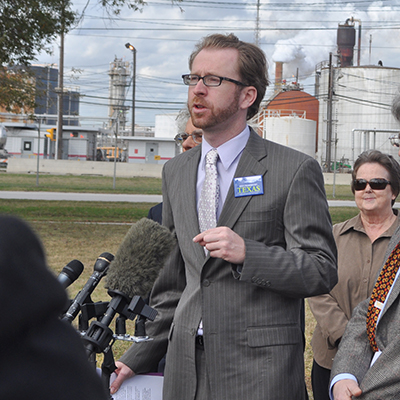
2018 Cool House Tour
This past Sunday I braced the scorching summer heat, along with other sustainability-oriented Austinites, to see some of the city’s greenest homes on display for the 22nd annual Cool House Tour. Beyond Energy Star appliances and solar panels, I had little to no knowledge on the types of fixes that could make homes more energy efficient. I was a little apprehensive to walk in the first house with my lack of knowledge, however, my insecurities faded quickly as I was met with welcoming smiles and by those willing to share their knowledge at every home.
Guest blog by Alexia Heinrich, a student at Cornell University and an intern with Environment Texas.
This past Sunday I braced the scorching summer heat, along with other sustainability-oriented Austinites, to see some of the city’s greenest homes on display for the 22nd annual Cool House Tour. Beyond Energy Star appliances and solar panels, I had little to no knowledge on the types of fixes that could make homes more energy efficient. I was a little apprehensive to walk in the first house with my lack of knowledge, however, my insecurities faded quickly as I was met with welcoming smiles and by those willing to share their knowledge at every home.
This tour was a great way to remind myself of some of good that can come from the harsh Texas sun: it can provide homeowners with enough energy to completely (or almost completely) power their homes! This was true for the very first home I visited- it was a Net Zero Energy certified building. However, this wasn’t always the case. Originally, the home was built in 1948 with little to no insulation and was far from being considered “green.” Today, with the help of 18 solar panels and other home improvements, like insulation, the home completely sustains itself without the use of fossil fuels.
I continued to be fascinated by this house because of what I was shown on the TV screen in the living room. The TV screen displayed how much various devices were using energy in the home, such as the refrigerator and AC, in real time. In the top right corner of the screen, pictured below, you could see how much electricity was being generated by the solar panels (in green) and how much energy was being consumed by the household (in red). Not surprisingly, the most energy intensive item was the air conditioning.
As I continued along on my tour, I got to see another home that was almost completely powered by the sun. With their solar panels, the highest electricity bill the homeowners had to pay since moving into the house 18 months ago was $15!
Solar selfie!
Not every home on the tour received enough direct sunlight to reap the benefits from solar panels. Yet, the homeowners had still managed to make significant improvements in efficiency. For example, a home shown on Wethersby Road was too shaded to ever have solar panels installed, but through recent renovations the homeowners electricity bill is anticipated to be 50% less than before.
This brings me to my biggest takeaway from my tour: renovations play a key role in lowering your electricity bill even in locations that are perfect for solar panels. While I was at this house on Wethersby, I asked Tommy Hudson of Hudson Custom Homes what the most important things were to consider when renovating a home in order to maximize efficiency. He cited 4 things you should pay attention to:
-
Windows: make sure they’re as energy efficient as possible. If possible, minimize the number of windows which face East and West, as they will receive the most sunlight. Also, consider overhangs as a way to protect the windows from direct sun.
-
Insulation: having good insulation reduces the amount of energy needed for heating and cooling
-
Spray foam your attic: this prevents any air from escaping your home
-
Reflective roof: to prevent heat absorption
Authors
Luke Metzger
Executive Director, Environment Texas
As the executive director of Environment Texas, Luke is a leading voice in the state for clean air and water, parks and wildlife, and a livable climate. Luke recently led the successful campaign to get the Texas Legislature and voters to invest $1 billion to buy land for new state parks. He also helped win permanent protection for the Christmas Mountains of Big Bend; helped compel Exxon, Shell and Chevron Phillips to cut air pollution at four Texas refineries and chemical plants; and got the Austin and Houston school districts to install filters on water fountains to protect children from lead in drinking water. The San Antonio Current has called Luke "long one of the most energetic and dedicated defenders of environmental issues in the state." He has been named one of the "Top Lobbyists for Causes" by Capitol Inside, received the President's Award from the Texas Recreation and Parks Society for his work to protect Texas parks. He is a board member of the Clean Air Force of Central Texas and an advisory board member of the Texas Tech University Masters of Public Administration program. Luke, his wife, son and daughters are working to visit every state park in Texas.

